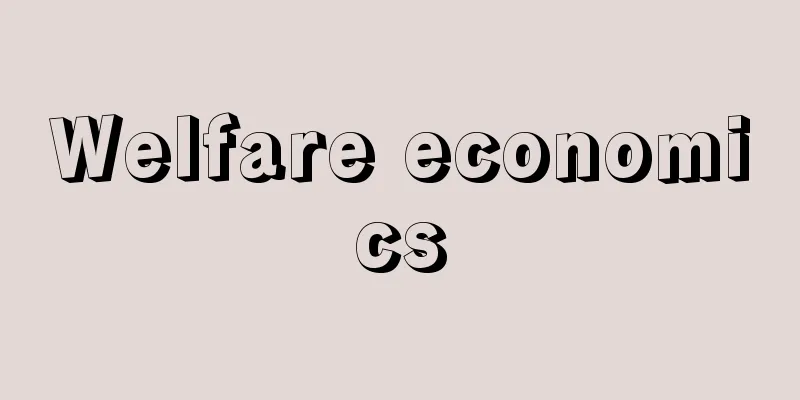Welfare economics

|
Welfare economics is generally understood as a branch of economics that began with A.C. Pigou's major work, The Economics of Welfare (1920), but many of the propositions derived by Pigou in that book were stated by his teacher A. Marshall in a simple form without being specifically called welfare economics, and some argue that almost all major economics since A. Smith are in fact welfare economics to a greater or lesser extent. After World War II, the tendency to call the basic theory of economic policy and normative economics in general welfare economics has spread, and there are also differences of opinion as to whether the theory of social choice started by K.J. Arrow and public economics, which can be said to have gained almost universal acceptance both at home and abroad around 1970, should be included in welfare economics. Currently, the definition of welfare economics that is accepted by almost everyone is a very vague and general one, that of economic analysis that deals with social welfare or welfare. As for Pigou, he called the part of social welfare that can be directly or indirectly measured with money "economic welfare," and based on the assumption that there is generally a positive correlation between the two, he focused his study on the national share (national income) and derived the famous "three propositions of welfare economics" regarding the three aspects of production, distribution, and fluctuation. After the second edition of "Welfare Economics" (1924), the part dealing with fluctuation was moved to the independent "Industrial Fluctuations" (1926), and since then, only the static aspect has been mainly discussed in welfare economics. However, the second proposition on distribution, "other things being equal, the economic welfare of society increases as the gap between rich and poor decreases," cannot be derived strictly without the assumptions of cardinal utility (measurability in absolute magnitude) and interpersonal comparability of utility, which Pigou implicitly assumed. However, both assumptions were criticized in the early 1930s by K. G. Myrdal and, more directly, L. C. Robbins, for being unable to empirically prove them. Since then, welfare economics has abandoned the assumption of cardinal utility and adopted an ordinal concept of utility, and has largely moved away from distribution issues that require the assumption of interpersonal comparability of utility, limiting analysis to the production side, and transitioning to the so-called "new welfare economics" centered around J. R. Hicks and N. Kaldor, which is centered around the concept of "Pareto optimality" and is accompanied by the compensation principle. New welfare economics initially seemed to assume that by abandoning the two previous assumptions about utility, it had become free from value judgments; however, in that it regards the economic welfare of society as the sum of the economic welfare of the individuals who make up that society, it still contains value judgments. This point was gradually clarified from the late 1930s through research by A. Bergson (then known as A. Burke) and P. A. Samuelson, who conceived of the social welfare function, and when Arrow's general possibility theorem was presented in 1951, welfare economics, for a time, appeared to have reached a complete dead end. As I wrote at the beginning, even today, the definition of welfare economics varies from person to person, and in today's economic policy theory, the relationship between efficiency and fairness is questioned, the theory of second best is discussed, and the aspects are quite diverse, but the idea of new welfare economics still plays a central role, especially the concept of "Pareto optimum", and the proposition that "all competitive equilibria are Pareto optimum points, and all Pareto optimum points are competitive equilibria" is called the "Fundamental Theorem of Welfare Economics". In addition, the theory of internal and external economics, which plays an important role in the analysis of pollution, and issues such as the discrepancy between private marginal net product and social marginal net product, are in line with the ideas that began with Marshall and were developed by Pigou. [Tadashi Hayasaka] "Welfare Economics" by A.C. Pigou, supervised and translated by Kiyoshi Nagata, 4 volumes (1953-55, Toyo Keizai Shinposha)" ▽ "Price Theory II" by Kenichi Imai et al. (1971, Iwanami Shoten)" ▽ "Public Economics" edited by Yukihide Okano and Takashi Negishi (1973, Yuhikaku)" ▽ "Economics 2: Welfare Economics" edited by Kenjiro Ara et al. (1976, Yuhikaku)" ▽ "Welfare Economics" by Naoo Kumagai (1978, Sobunsha)" [References] | | | | | | | | | | |Source: Shogakukan Encyclopedia Nipponica About Encyclopedia Nipponica Information | Legend |
|
厚生経済学は、通常、A・C・ピグーの主著『厚生経済学』The Economics of Welfare(1920)から始まった経済学の一分野と解されているが、ピグーが同書で導出した命題のかなりの部分は、とくに厚生経済学と銘打つこともなく簡単な形でだが、師のA・マーシャルが述べているし、A・スミス以来の主要な経済学のほとんどすべては、実質上、多かれ少なかれ厚生経済学だ、と説く論者もいる。また第二次世界大戦以後になると、経済政策の基礎理論や規範的経済学一般を厚生経済学とよぶ傾向が広まっており、さらにK・J・アローに始まる社会的選択の理論や、1970年前後に内外でほぼ市民権を獲得したとみてよい公共経済学public economicsをも厚生経済学に含めるか否かについても意見が分かれており、現在、厚生経済学についてほぼだれもが承認する定義は、社会の厚生ないし福祉welfareを問題にする経済分析という非常に漠然とした一般的なもの以外、ないに等しい。 ピグーについていうと、彼は社会の厚生一般のなかで直接・間接に貨幣で測定できる部分を「経済的厚生」とよび、両者は一般に正(プラス)の相関関係があるという想定のもとに、国民分配分(国民所得)を中心に考察を進め、生産・分配・変動の三面に関する有名な「厚生経済学の三命題」を導出した。このうち変動を扱った部分は『厚生経済学』の第2版(1924)以降、独立の『産業変動論』(1926)に移されたため、以後、厚生経済学としては静学面だけがおもに論じられるようになった。しかし、「他の条件にして等しい限り、社会の経済的厚生は貧富の懸隔が減少すればするほど増大する」という分配に関する第二命題は、ピグーが暗黙裏に想定していた効用の基数性(絶対的大きさでの測定可能性)と効用の個人間での比較可能性の前提がない限り、厳密には導出不可能だが、そのどちらの前提もが経験的には実証不可能であることが、1930年代前半に、K・G・ミュルダール、より直接のきっかけとしてはL・C・ロビンズによって批判された。以後、厚生経済学は、効用の基数性の仮定を捨てて序数的効用概念をとり、また効用の個人間での比較可能性の仮定を必要とする分配問題をほぼ離れて、生産面に分析を限定し、「パレート最適」概念を中心に、補償原理などを随伴する、J・R・ヒックスやN・カルドアらが中心の通称「新厚生経済学」new welfare economicsの局面に移行した。 新厚生経済学は、当初、効用に関する先の二つの仮定を捨てることによって価値判断から自由になったと想定していたようであるが、社会の経済的厚生を、社会を構成している個々人の経済的厚生の総和とみなす点では、依然として価値判断を含んでおり、この点が1930年代末葉からA・バーグソン(当時はA・バークと称した)やP・A・サミュエルソンらの社会(的)厚生関数social welfare functionの構想を伴う研究によって徐々に明らかにされ、その延長線上に、1951年にアローの一般可能性定理が提出されるに及んで、厚生経済学は、一時、まったく行き詰まったかの観を呈した。 冒頭に書いたように、現在も厚生経済学が何をさすかは人によって一定していないし、今日の経済政策論では効率と公正の関係が問われたり、次善の理論が論じられたり、様相はかなり多様化しているが、依然そこで中心的役割を演じているのは新厚生経済学の考え方、ことに「パレート最適」概念で、「すべての競争均衡はパレート最適点であり、すべてのパレート最適点は競争均衡である」という命題が「厚生経済学の基本定理」とよばれている。また、公害の分析などで重要な役割を演じている内部・外部経済論、私的限界純生産物と社会的限界純生産物との乖離(かいり)などの問題は、マーシャルに始まり、ピグーが展開した考えの線上のものである。 [早坂 忠] 『A・C・ピグー著、永田清監訳『厚生経済学』全4冊(1953~55・東洋経済新報社)』▽『今井賢一他著『価格理論Ⅱ』(1971・岩波書店)』▽『岡野行秀・根岸隆編『公共経済学』(1973・有斐閣)』▽『荒憲治郎他編『経済学2 厚生経済学』(1976・有斐閣)』▽『熊谷尚夫著『厚生経済学』(1978・創文社)』 [参照項目] | | | | | | | | | | |出典 小学館 日本大百科全書(ニッポニカ)日本大百科全書(ニッポニカ)について 情報 | 凡例 |
>>: Commentary on the Sutra of the Emperor
Recommend
Euripides - Euripides (English spelling)
He is one of the three great tragic poets of anci...
flon
...A general name used only in Japan for fluoroca...
Alnus pendula (English spelling) Alnuspendula
… [Okamoto Motoji]. … *Some of the terminology th...
Money of Omi - Money of Omi
?-? A courtesan from the Kamakura period. A nativ...
Kimuro Uun
Year of death: June 28, 1783 (July 27, 1783) Year ...
Canal Colony
…In contrast, the irrigation canals of the rivers...
Balance function test
This test is performed on patients who complain of...
Pedrolino
...In Japan, the name is often confused with that...
Porcupine (Japanese porcupine)
A general term for rodents with long, sharp, needl...
Statius (English spelling) Publius Papinius Statius
Ancient Roman poet. Born in Naples. He was taught...
Osiris - English spelling Osiris
A male deity widely worshipped as the god of the ...
Pathotoxin
…Among the metabolic products secreted by plant p...
Kagura Song - Kagura Uta
Kagura and folk songs are sung during Kagura perf...
Forgiveness - Osha
...The announcement of the sentence is called set...
Sorex hosonoi (English spelling)
…[Yoshiharu Imaizumi]. … *Some of the terminology...









